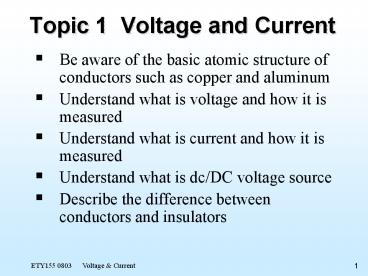Topic 1 Voltage and Current
1 / 15
Title:
Topic 1 Voltage and Current
Description:
Be aware of the basic atomic structure of conductors such as copper and aluminum ... have only one electron in the valance (most distant from the nucleus) ring. ... –
Number of Views:131
Avg rating:3.0/5.0
Title: Topic 1 Voltage and Current
1
Topic 1 Voltage and Current
- Be aware of the basic atomic structure of
conductors such as copper and aluminum - Understand what is voltage and how it is measured
- Understand what is current and how it is measured
- Understand what is dc/DC voltage source
- Describe the difference between conductors and
insulators
2
1.1 - Voltage
- A potential difference of 1 volt (V) exists
between two points if 1 joule (J) of energy is
exchanged in moving, or required to move, 1
coulomb (C) of charge between the two points - The unit of measurement volt was chosen to honor
Alessandro Volta - 1 coulomb (C) of charge equals the charge of
6.242 x 1018 electrons
3
Voltage
- A potential difference or voltage is always
measured between two points in the system.
Changing either point may change the potential
difference between the two points under
investigation. - Potential difference between two points is
determined by - (volts) (2.2)
- V volts (V), W joules (J), Q coulombs (C)
4
Voltage
- Example 2.1 in the text Find the voltage between
two points if 60 J of energy are required to move
a charge of 20 C between the two points. - Example 2.2 in the text Determine the energy
expended moving a charge of 50 ?C between two
points if the voltage between the two points is 6
V.
5
Voltage
- Notations for sources of voltage and loss of
potential - E - Voltage sources (volts)
- V - Voltage drops (volts)
- Potential The voltage at a point with respect
to another point in the electrical system.
Typically the reference point is the ground,
which is at zero potential.
6
Voltage
- Potential difference The algebraic difference
in potential (or voltage) between two points of a
network. - Voltage When isolated, like potential, the
voltage at a point with respect to some reference
such as ground. - Voltage difference The algebraic difference in
voltage (or potential) between two points of a
system. A voltage drop or rise is as the
terminology would suggest. - Electromotive force (emf) The force that
establishes the flow of charge (or current) in a
system due to the application of a difference in
potential.
7
1.2 - Current
- The free electron is the charge carrier in a
copper wire or any other solid conductor of
electricity
Fig. 2.2 The atomic structure of copper.
8
Current
- With no external forces applied, the net flow of
charge in a conductor in any one direction is zero
- A battery applies a voltage in a basic circuit to
establish a flow of charge, or current.
Fig. 2.9 Basic electric circuit.
9
Current
- The current is determined by
- (amperes) (2.5)
- I amperes (A), Q coulombs (C),
- t time (in seconds s)
- Example 2.3 in the text The charge flowing
through the imaginary surface in Fig. 2.9 is
0.16C every 64 ms. Determine the current in
amperes.
10
Current
- Safety considerations
- Even small levels of current through the human
body can cause serious, dangerous side effects - Any current over 10 mA is considered dangerous
- currents of 50 mA can cause severe shock
- currents over 100 mA can be fatal
- Treat electricity with respect not fear
11
1.3 Voltage Sources
- dc Direct current
- Unidirectional (one direction) flow of charge
- Supplies that provide a fixed voltage or current
- dc Voltage sources
- Batteries (chemical action)
- Generators (electromechanical)
- Power supplies (rectification)
12
Voltage Sources
- Ampere-hour rating
- Batteries have a capacity rating in ampere-hours
- A battery with an ampere-hour rating of 100 will
theoretically provide a steady current of 1A for
100 h, 2A for 50 h or 10A for 10 h - Factors affecting the rating rate of discharge
and temperature - The capacity of a dc battery decreases with an
increase in the current demand - The capacity of a dc battery decreases at
relatively (compared to room temperature) low and
high temperatures
13
1.4 Conductors and Insulators
- Conductors are those materials that permit a
generous flow of electrons with very little
external force (voltage) applied In addition, - Good conductors typically have only one electron
in the valance (most distant from the nucleus)
ring.
14
Conductors and Insulators
- Insulators are those materials that have very
few free electrons and require a large applied
potential (voltage) to establish a measurable
current level - Insulators are commonly used as covering for
current-carrying wire, which, if uninsulated,
could cause dangerous side effects - Rubber gloves and rubber mats are used to help
insulated workers when working on power lines - Even the best insulator will break down if a
sufficiently large potential is applied across it - Semiconductors are a specific group of elements
that exhibit characteristics between those of
insulators and conductors
15
Highlight of the Topic
- The applied potential difference (in volts) of a
voltage source in an electric circuit is the
pressure to set the system in motion and
cause the flow of charge or current through the
electrical system. - Reading Chapter 2
- Problems of Chapter 2 7-20































